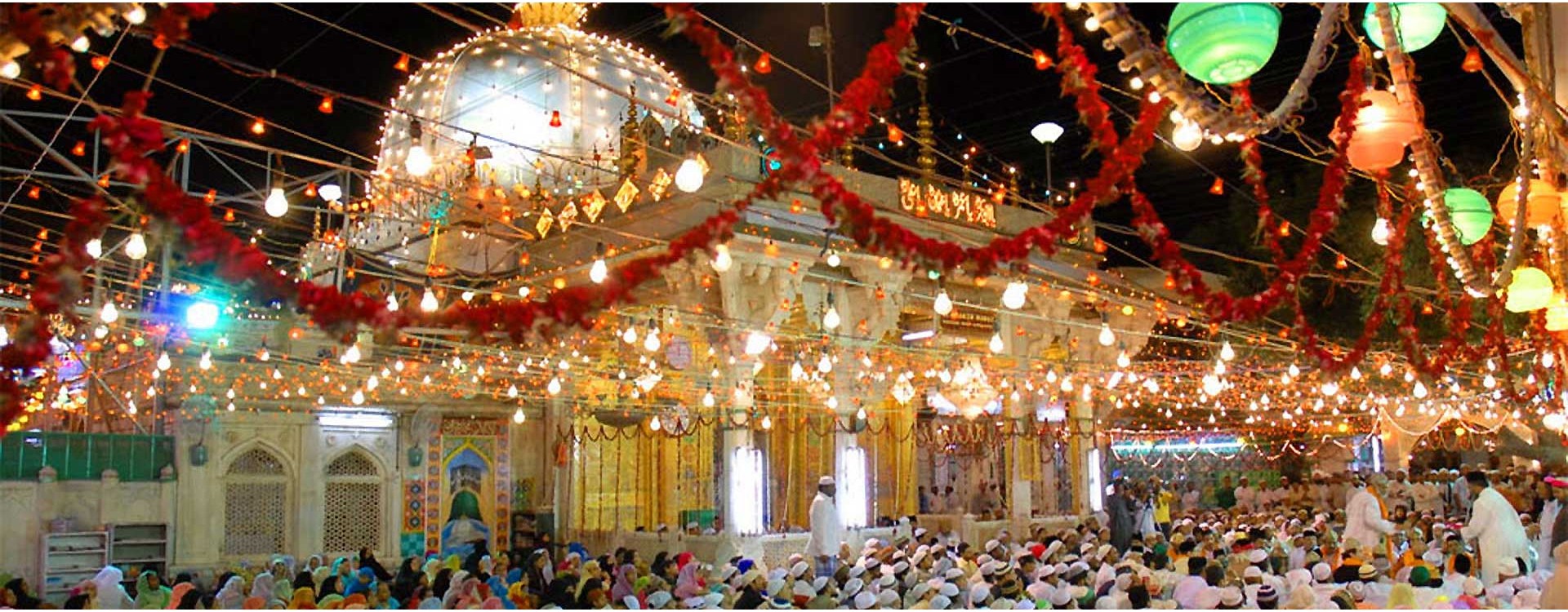Ajmer is bustling city, located 130 km southwest of Jaipur and just 14 km from the pilgrimage town of Pushkar. The city of Ajmer gets its name from "Ajay Meru", which can be roughly translated as “invincible hill”. Home to a number of tourist places, Ajmer can be a perfect representation of the diversity of the Indian culture and ethics, and displays a perfect blend of religion, community, culture, etc., coexisting and flourishing in harmony.
Ajmer remains a popular tourist attraction, in addition to being a pilgrimage centre for both Hindus and Muslims. The final resting place of the Sufi Saint, Khwaja Moinuddin Hasan Chisti, is visited by Muslims from all over the world; in fact, the Dargah is revered equally by both Hindus and Muslims. The city is surrounded by the expansive lake of Ana Sagar and the rugged hills of Aravalli. Although Ajmer Sharif Dargah, the shrine of Khwaja Muin-ud-din Chishti, remains as the most famous tourist places to visit in Ajmer, the city is also significantly known for the Jain religion and is home to an amazing golden Jain Temple. Ajmer is also a well-known learning centre.
The Mayo College was one of India’s first schools that acted as the stepping stone for the British style of education and is now one of the popular places to visit in Ajmer.
History
Ajmer was founded by Ajayadeva, an 11th-century Rajput ruler. It was annexed to the Delhi sultanate’s Slave dynasty in 1193. Upon payment of tribute it was returned to its Rajput rulers, but it was taken in 1556 by the Mughal emperor Akbar (reigned 1556–1605). In 1770 it was annexed by the Marathas, after which the area was a continual Rajput-Maratha battleground until it was ceded to the British in 1818. In 1878 the region of Ajmer was constituted as a chief commissioner’s province known as Ajmer-Merwara and was divided into two separate tracts. The larger of these comprised Ajmer and Merwara subdivisions; the smaller, to the southeast, comprised Kekri subdivision. Ajmer became a part of the state of Rajasthan in 1956.The city was founded by Raja Ajaypal Chauhan in the 7th century AD and the city remained as the epicentre of the Chauhan Dynasty till the 12th century AD. The Chauhan dynasty was responsible for the construction of the first hill fort of India, Taragarh, another must visit places in Ajmer. After the defeat of Prithviraj Chauhan by Mohammed Ghori, Ajmer become home to a number of dynasties. The Mughal Sultans particularly liked Ajmer due the presence of the holy Ajmer Sharif Dargah, the most popular tourist place in the city. Ajmer has a rich history and played host to the first meeting between the Mughal King Jahangir and the Ambassador of the Court of King James 1 of England, Sir Thomas Roe in 1616. The city was officially handed over to the British a few centuries later, making Ajmer the only region in Rajputana to be directly controlled by the British East India Company.
Places to Visit
There are number of places to visit near Ajmer, Pushkar, which is about 14 kmremains as the most popular destination. Pushkar is a sacred spot for Hindus. The only known temple dedicated to Lord Brahma is situated in Pushkar and Hindus visit the city in large numbers during the month of Karthik to take a dip in the holy sarovar. Another tourist place near Ajmer that one can visit is the Lake Foy Sagar, an artificial lake. The lake was built by English Engineer Mr Foy in 1892 AD. The primary objective behind the construction of the lake was to provide famine relief through employment for the locals. The lake offers some breath taking views of the Aravalli range.
Eating in Ajmer
Ajmer is a melting pot of culture. The places to see in Ajmer are proof of this, from the Dargah to the Jain Temple. This mingling of cultures has influenced the city’s eating scene as well. One can enjoy traditional Rajasthani cuisine along with dishes influenced by the Mughal and British cultures. One can also find street vendors dishing out everyone’s favourite street food.
Best Time to Visit
The best time visit Ajmer is between October and February. The weather remains very pleasant during this time. The daytime temperature during this time encourages visits to various tourist places to see in Ajmer. The summer months, from March to May, are best to be avoided, as the temperature can easily cross 40° C, which is not conducive for visiting places of attractions in Ajmer.
One can contact the tourist offices and book a suitable Ajmer tour package to fully enjoy the various tourist places in Ajmer. Most Ajmer tour packages will include conveyance and accommodation.
How to Reach Ajmer
Ajmer is a jewel of a town nestled in the Aravallis at the heart of Rajasthan. The former princely state has much to offer owing to its immense historic presence. It houses the much vaunted pilgrimage site, the shrine of the great Sufi Khwaja Moinuddin Chishti. Despite its seemingly remote nature, Ajmer is surprisingly accessible from nearly every part of the country.
By Air:
If you prefer to travel by air, you can reach Ajmer through the Sanganer Airport in Jaipur, the closest airport to Ajmer, from then on it is approximately 135 km away.
By Train:
The city is well connected by the railways so you are welcome to take a train to Ajmer Railway junction, which is the nearest railway station. There are superfast trains, express and mail trains to Ajmer. The station is also well connected to cities like Kolkata, Delhi, Jaipur, Pune, Lucknow and Allahabad.
By Road:
Ajmer is nearly 132 km away from Jaipur and about 388 km from Delhi. There are plenty of buses available from Ajmer to Delhi and Jaipur.There are both AC and Volvo buses running. State transport buses are connected to many critical destinations comprising of Udaipur, Jodhpur, Bundi, Bharatpur, Bikaner and Jaisalmer.






